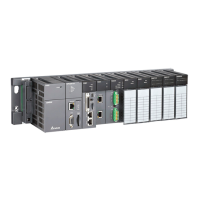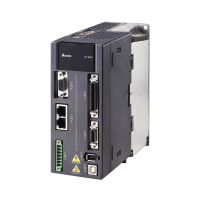AH500 Programming Manual
6-316
6.15.2 Explanation of Module Instructions
API
Instruction code Operand
Function
1400 D
FROM P
m
1
,
m
2
,
m
3
,
D
1
,
D
2
,
n
Reading the data from the control
register in the special module
Device
X Y M S T C HC D L SM SR E PR K 16# “$” DF
m1
m2
m3
1
2
Pulse instruction
16-bit instruction (13 steps)
32-bit instruction (13 steps)
Symbol:
m
1
:
Rack code Word/Double word
m
2
:
Slot code Word/Double word
m
3
:
Control register number Word/Double word
D
1
:
Device in which the data is
stored
Word/Double word
D
2
:
Device in which the error
code is stored
Word/Double word
n
:
Data length Word/Double word
Explanation:
1. Users can use this instruction to read the data from the control register in the special module
into the AH500 series PLC.
2. The operand m
1
should be within the range between 1 and 8. 1 represents a main rack, and
2~8 represent extension racks.
3. The operand m
2
should be within the range between 0 and 11. If the rack code is 1, the slot
code should be within the range between 0 and 11. If the rack code is within the range
between 2 and 8, the slot code should be within the range between 0 and 7.
4. The operand m
3
specifies the control register number.
5. When the instruction FROM is executed, D
2
is set to 0. When an error occurs, D
2
is not set to 0.
Please refer to the additional remark below for more information about the error codes.
6. The operand n used in the 16-bit instruction should be within the range between 1 and 256,
and the operand n used in the 32-bit instruction should be within the range between 1 and 128.
7. Only the 32-bit instructions can use the 32-bit counter.
8. Please refer to the regulation of the operands in the instruction TO for more information about
the numbering of the special modules.
9. Special modules include analog I/O modules, network I/O modules, and position I/O modules.
Example:
Suppose the first special module at the right side of the CPU module is AH50010SCM-A5. When

